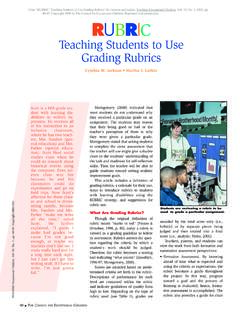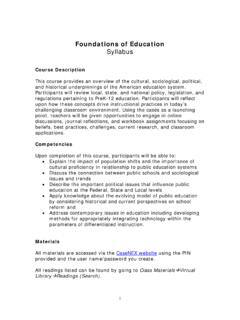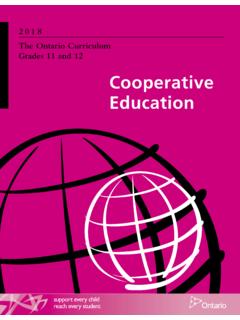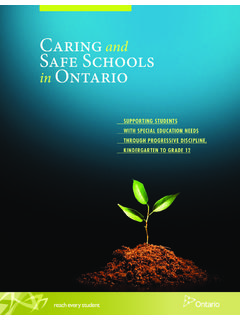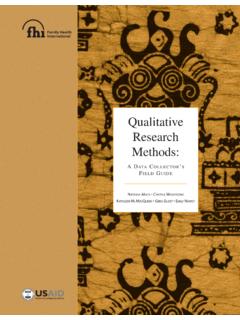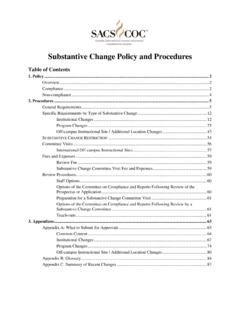Transcription of How Cooperative Learning Works for Special Education and ...
1 Ur aim in this research was todescribe what general educa-tion teachers think about co-operative Learning as aninstructional approach forspecial and remedial Education students. Johnson,Johnson, and Holubec (1993) described coopera-tive Learning as the instructional use of smallgroups so that students work together to maxi-mize their own and each other s Learning (p. 6).Although researchers differ on the exact featuresthat define Cooperative Learning (Johnson et al.,1993; Kagan, 1989-90; Sharan, 1980; Slavin,1990), they generally agree that students mustwork together in small groups, make explicit ef-fort to help each other learn, and share in theevaluation of Learning ( , all members of agroup receive the same evaluation).Use of Cooperative Learning in elementaryclassrooms appears to be widespread.
2 A congres-sionally mandated study of educational opportu-nity covering 3 million third-grade students279 Exceptional ChildrenVol. 69, No. 3, pp. 279-292. 2003 Council for Exceptional Cooperative LearningWorks for Special Education and Remedial StudentsJOSEPH R. JENKINSU niversity of WashingtonLAURENCE R. ANTILW estern Washington UniversitySUSAN K. WAYNEU niversity of WashingtonPATRICIA F. VADASYW ashington Research InstituteABSTRACT:This study reports new analyses from an earlier study by Antil, Jenkins, Wayne, &Vadasy (1998) in which 21 general Education classroom teachers were interviewed about their useof Cooperative Learning . We report teachers perceptions of how Cooperative Learning benefits specialeducation and remedial students, the percentage of these students who consistently participated inclassroom Cooperative Learning activities, its efficacy for these students, and the kind of modifica-tions teachers made for students with Special needs.
3 Teachers were generally positive about coopera-tive Learning s efficacy for students with Learning problems, while acknowledging that it workedbetter for some students than others. Major benefits were improved self-esteem, a safe Learning en-vironment, and better classroom success rates and products. The primary modification for specialand remedial Education students was selecting suitable partners for ChildrenFrom How Cooperative Learning Works for Special Education and Remedial Studies by Jenkins, Antil, Wayne, and Vadasy, Exceptional Children, Vol. 69, No. 3, 2003, pp. 279-292. Copyright 2006 by The Council for Exceptional Children. Reprinted with permission. 280 Spring 2003(Puma, Jones, Rock, & Fernandez, 1993) foundthat a high percentage of their teachers said theyused Cooperative Learning in math (79%) andreading and language arts (74%).
4 Another surveyof 85 elementary school teachers in two schooldistricts found that 93% indicated they used co-operative Learning (Antil et al., 1998). An in-depth interview of a subset of those teachers whosaid they used this approach disclosed that 81%conducted Cooperative Learning lessons every dayin a typical week, with 100% reporting use of thestrategy for reading, and 81% for math. Teacherssaid they regularly used Cooperative Learning infour teachers had adopted cooperativelearning primarily because they believe it facili-tates academic Learning (79%), engenders activeparticipation in Learning (71%), and affords op-portunity for important social Learning (71%).Representative of academic Learning rationaleswere statements like Cooperative Learning in-creases comprehension and knowledge, it affectstheir general overall speed of Learning , Kidslearn much more from each other than maybe wewould like to believe.
5 They don t really need ateacher that much (Antil et al., 1998, p. 424).The primary mechanism through which teacherssaw Cooperative Learning affecting Learning is chil-dren s ability to talk to one another in specialways, or kid-talk. According to this belief, peer-mediated Learning occurs because one child hearsa well-put explanation from a team member,sometimes but not always communicated in aform that is particular to the way that childrenspeak. In the words of one teacher:They seem to have their own language. They areable to express their thoughts and ideas to eachother in a way that I can t. I use teacher lan-guage, and kids explain in kid language. And asmuch as I try to do that, I m still their m not a kid. (Antil et al., 1998, p. 424)Related to the active involvement rationale,teachers saw Cooperative Learning resulting inbroader student participation in lessons, more ac-tive Learning , or greater task engagement in class-room lessons as a result of working together.
6 Mostlinked deepertask engagement to peer interactionand activity-based assignments. Learning is enhanced. They retain s a hands-on experience. They re not sitting lis-tening to you in a Cooperative group. They redoing something. If they re all in little groupsand know their expectations, they can talk to-gether and not key each other out. (Antil et al.,1998, p. 425)The most salient idea related to sociallearning was that Cooperative Learning helps chil-dren learn to cooperate and to value also said that Cooperative Learning led tolearning specific skills ( , listening and re-sponding respectfully to peers contributions) andlearning to work with nonpreferred classmates. Sometimes I ll group kids who are having a hardtime together so that they have to hash out theirdifficulties (Antil et al.)
7 , 1998, p. 425).Teachers adoption of Cooperative learningcomes as good news for Special and remedial ad-vocates who see it helping a wide range of strug-gling learners overcome obstacles they might notovercome working alone and gaining access tochallenging curricula (Alberg, 1991; Johnson &Johnson, 1980; Slavin, 1990; Slavin & Stevens,1991; Slavin, Stevens, & Madden, 1988; Thou-sand & Villa, 1991; Will, 1986; Wood, Al-gozzine, & Avett, 1993). In Cooperative Learning ,peers can clarify the nature of an assignment, in-terpret complex instructions, model performance,explain ideas, give feedback and corrections, takeresponsibility for difficult parts of the assignment,scaffold problem-solving efforts, and provide general Education teachers maybe using Cooperative Learning and Special educa-tors advocating its use, the efficacy picture for co-operative Learning with Special Education studentsremains cloudy.
8 Two observational studies of spe-cial Education students in Cooperative learningyielded a mix of positive and negative results(Beaumont, 1999, O Connor & Jenkins, 1996).Likewise, experimental studies of Special educa-tion students achievement in Cooperative learningreport a similar mixture of outcomes, leading tolukewarm research reviews, The opportunity forstudents to study together does not guaranteegains in academic achievement (Tateyama-Sniezek, 1990, p. 436); and ..in light of the in-clusive findings in the research literatureregarding the efficacy of using Cooperative learn-ing (CL) with students with Learning disabilities(LD), teachers may wish to exercise caution in de-ciding whether to use CL to improve these stu-dents academic performance (McMaster &Fuchs, 2002, p.)
9 116).It is hard to reconcile the inconsistent re-search findings on Cooperative Learning with thestrong advocacy for it found in the Special educa-tion literature. However, one voice notably miss-ing from the conversation about cooperativelearning s efficacy is that of classroom teacherswho use this approach with Special Education andremedial students. Teachers have more opportu-nities than perhaps anyone to gauge how studentswith Learning problems respond to cooperativelearning. Their perspective could add an impor-tant dimension to the knowledge base on how co-operative Learning Works for students withdisabilities. In this article, we report general edu-cation teachers thoughts about Cooperative learn-ing s use with Special and remedial educationstudents. Elementary classroom teachers spokeabout their perceptions of Cooperative Learning sbenefits for Special and remedial Education stu-dents, the percentage of these students who con-sistently participated in Cooperative learninglessons, the efficacy of Cooperative Learning forstruggling students, and modifications they madein Cooperative Learning to accommodate specialand remedial Education students.
10 Data in thisstudy are based on a set of interview responsesthat were given in connection with the Antil et al.(1998) Cooperative Learning research. METHODSCHOOLSANDTEACHERSS chools. Teachers from two urban (low income)and two suburban (upper middle income) ele-mentary schools, located in the United States,participated in the interviews. The urban schoolswere similar in racial composition: approximately24% were Asian American, 38% African Ameri-can, and 36% Caucasian students, with 42% ofthe student body qualifying for free or reducedlunch. The two suburban schools had similar stu-dent demographics: approximately 5% AsianAmerican, 2% African American, and 92% Cau-casian students, with 7% of students eligible forfree or reduced lunch. Teachers. In an earlier stage of this study, 85teachers (all grade-level teachers from six schools)completed a survey on their Cooperative learningpractices.


